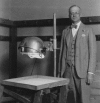SOLAR ultraviolet radiation and vitamin D: a historical perspective
- PMID: 17761571
- PMCID: PMC1994178
- DOI: 10.2105/AJPH.2006.091736
SOLAR ultraviolet radiation and vitamin D: a historical perspective
Erratum in
- Am J Public Health. 2007 Dec;97(12):2121
Abstract
Rickets, the state of vitamin D deficiency, has reemerged as a potential problem in the United States. At the dawn of the 20th century, rickets was pervasive among infants residing in the polluted cities of Europe and the northeastern United States. Important milestones in the history of rickets were the understanding that photosynthesized vitamin D and dietary vitamin D were similar, the discernment of the antirachitic potency of artificial and natural ultraviolet rays, and the discovery that ultraviolet irradiation could render various foods antirachitic. Clinical guidelines were instituted to promote sensible exposure to sunlight and artificial ultraviolet radiation. In addition, irradiated ergosterol from yeast became the major vitamin D source for food fortification and the treatment of rickets, leading to a public health campaign to eradicate rickets by the 1930s. We review the sequence and turn of events pertaining to the discovery of vitamin D and the strategies for the eradication of the reemerging rickets problem.
Figures
References
-
- Severe malnutrition among young children—Georgia, January 1997–June 1999. MMWR Morb Mortal Wkly Rep. 2001;50:224–227. - PubMed
-
- Tomashek KM, Nesby S, Scanlon KS, et al. Nutritional rickets in Georgia. Pediatrics. 2001;107:E45. Available at: http://www.pediatrics.org/cgi/content/full/107/4/e45. Accessed July 15, 2007. - PubMed
-
- Kreiter SR, Schwartz RP, Kirkman HN Jr, Charlton PA, Calikoglu AS, Davenport ML. Nutritional rickets in African-American breast-fed infants. J Pediatr. 2000;137:153–157. - PubMed
-
- Biser-Rohrbaugh A, Hadley-Miller N. Vitamin D deficiency in breast-fed toddlers. J Pediatr Orthop. 2001;21: 508–511. - PubMed
-
- Weisberg P, Scanlon KS, Li R, Cogswell ME. Nutritional rickets among children in the United States: review of cases reported between 1986 and 2003. Am J Clin Nutr. 2004;80:1697S–1705S. - PubMed
Publication types
MeSH terms
Substances
Grants and funding
LinkOut - more resources
Full Text Sources
Other Literature Sources
Medical



